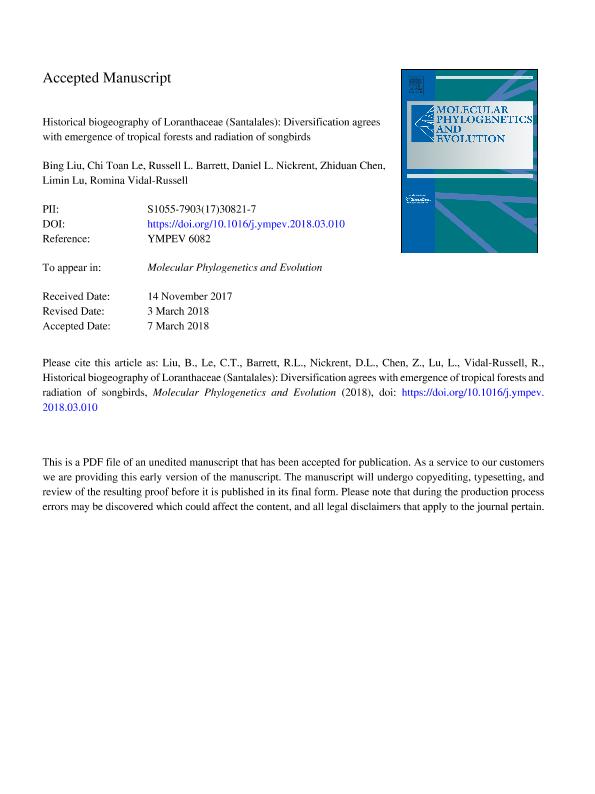Mostrar el registro sencillo del ítem
dc.contributor.author
Liu, Bing
dc.contributor.author
Le, Chi Toan
dc.contributor.author
Barrett, Russell L.
dc.contributor.author
Nickrent, Daniel L.
dc.contributor.author
Chen, Zhiduan
dc.contributor.author
Lu, Limin
dc.contributor.author
Vidal Russell, Romina

dc.date.available
2019-11-26T21:18:46Z
dc.date.issued
2018-07
dc.identifier.citation
Liu, Bing; Le, Chi Toan; Barrett, Russell L.; Nickrent, Daniel L.; Chen, Zhiduan; et al.; Historical biogeography of Loranthaceae (Santalales): Diversification agrees with emergence of tropical forests and radiation of songbirds; Academic Press Inc Elsevier Science; Molecular Phylogenetics and Evolution; 124; 7-2018; 199-212
dc.identifier.issn
1055-7903
dc.identifier.uri
http://hdl.handle.net/11336/90592
dc.description.abstract
Coadaptation between mistletoes and birds captured the attention of Charles Darwin over 150 years ago, stimulating considerable scientific research. Here we used Loranthaceae, a speciose and ecologically important mistletoe family, to obtain new insights into the interrelationships among its hosts and dispersers. Phylogenetic analyses of Loranthaceae were based on a dataset of nuclear and chloroplast DNA sequences. Divergence time estimation, ancestral area reconstruction, and diversification rate analyses were employed to examine historical biogeography. The crown group of Loranthaceae was estimated to originate in Australasian Gondwana during the Paleocene to early Eocene (59 Ma, 95% HPD: 53–66 Ma), and rapidly diversified, converting from root parasitic to aerial parasitic trophic mode ca. 50 Ma during the Eocene climatic optimum. Subsequently, Loranthaceae were inferred to be widespread in Australasia and South America but absent in Africa. The African and European members were derived from Asiatic lineages. The burst of diversification of Loranthaceae occurred during a climatic optimum period that coincides with the dominance of tropical forests in the world. This also corresponds to the trophic mode conversion of Loranthaceae and rapid radiation of many bird families – important agents for long-distance dispersal in the Cenozoic.
dc.format
application/pdf
dc.language.iso
eng
dc.publisher
Academic Press Inc Elsevier Science

dc.rights
info:eu-repo/semantics/openAccess
dc.rights.uri
https://creativecommons.org/licenses/by-nc-nd/2.5/ar/
dc.subject
DIVERGENCE TIME
dc.subject
EOCENE
dc.subject
GONDWANA
dc.subject
LONG-DISTANCE DISPERSAL
dc.subject
MISTLETOE
dc.subject.classification
Ciencias de las Plantas, Botánica

dc.subject.classification
Ciencias Biológicas

dc.subject.classification
CIENCIAS NATURALES Y EXACTAS

dc.title
Historical biogeography of Loranthaceae (Santalales): Diversification agrees with emergence of tropical forests and radiation of songbirds
dc.type
info:eu-repo/semantics/article
dc.type
info:ar-repo/semantics/artículo
dc.type
info:eu-repo/semantics/publishedVersion
dc.date.updated
2019-10-10T13:54:42Z
dc.journal.volume
124
dc.journal.pagination
199-212
dc.journal.pais
Estados Unidos

dc.journal.ciudad
Nueva York
dc.description.fil
Fil: Liu, Bing. Chinese Academy of Sciences; República de China
dc.description.fil
Fil: Le, Chi Toan. Chinese Academy of Sciences; República de China. University of Chinese Academy of Sciences; China
dc.description.fil
Fil: Barrett, Russell L.. National Herbarium of New South Wales; Australia. Centre for Australian National Biodiversity Research. Australian National Herbarium; Australia
dc.description.fil
Fil: Nickrent, Daniel L.. University Carbondale; Estados Unidos
dc.description.fil
Fil: Chen, Zhiduan. Chinese Academy of Sciences; República de China
dc.description.fil
Fil: Lu, Limin. Chinese Academy of Sciences; República de China
dc.description.fil
Fil: Vidal Russell, Romina. Consejo Nacional de Investigaciones Científicas y Técnicas. Centro Científico Tecnológico Conicet - Patagonia Norte. Instituto de Investigaciones en Biodiversidad y Medioambiente. Universidad Nacional del Comahue. Centro Regional Universidad Bariloche. Instituto de Investigaciones en Biodiversidad y Medioambiente; Argentina. Universidad Nacional del Comahue. Centro Regional Universitario Bariloche. Laboratorio de Ecotono; Argentina
dc.journal.title
Molecular Phylogenetics and Evolution

dc.relation.alternativeid
info:eu-repo/semantics/altIdentifier/doi/http://dx.doi.org/10.1016/j.ympev.2018.03.010
dc.relation.alternativeid
info:eu-repo/semantics/altIdentifier/url/https://www.sciencedirect.com/science/article/pii/S1055790317308217?via%3Dihub
Archivos asociados
